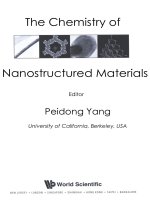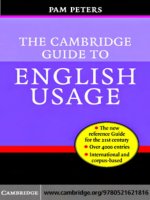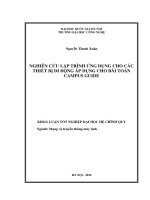Experiment guide chemistry cambridge igcse
Bạn đang xem bản rút gọn của tài liệu. Xem và tải ngay bản đầy đủ của tài liệu tại đây (2.66 MB, 64 trang )
HO CHI MINH CITY OF UNIVERSITY OF PEDAGOGY
DEPARTMENT OF CHEMISTRY
Student: Nguyen Thi Thanh Nhon
Supervisor: MS Thai Hoai Minh
Topic 1: The nature of matter
experiment 1: solid-liquid-gas.......................................................... 3
experiment 2: change in physical states .......................................... 4
experiment 3: dry ice ....................................................................... 5
experiment 4: separate solid ............................................................ 6
experiment 5: separate liquid .......................................................... 7
Topic 2: Chemical reaction
experiment 6: physical change and chemical change ....................... 10
experiment 7: exothermic and endothermic process......................... 11
experiment 8: synthesis reaction ..................................................... 12
experiment 9: combustion .............................................................. 13
experiment 10: displacement reaction ............................................. 13
experiment 11: decomposition reaction............................................ 13
Topic 3: Acids, bases
experiment 12: decode the quiz ....................................................... 16
experiment 13: colourful tubes ........................................................ 17
experiment 14: strong-medium-weak............................................... 18
Topic 4: How far? How fast?
experiment 15 : hot and cold ........................................................... 20
experiment 16: elephant toothpaste ................................................. 21
Topic 5: Aluminium
experiment 17: coke can ................................................................. 23
experiment 18: detect aluminium .................................................... 23
Exercise solution ........................................................................... 25
Lesson plan “What is an acid?” ........................................................ 32
Lesson plan “ Energy changes in chemical reaction” ........................ 44
Lesson plan “Aluminium” ................................................................ 54
1
2
DIFFERENT TYPES OF SUBSTANCE
(LESSON 2.1)
Experiment 1: SOLID-LIQUID-GAS
Objective
Student can state the properties of 3 states: solid, liquid, gas.
Apparatus and Chemical
Apparatus
Three beakers 25ml
Chemical
Ice cube
Cool water: 10 ml
Boiling water: 10ml
Direction
Teacher prepares a beaker of ice cubes, a beaker of cool water and a
beaker of boiling water.
Student observes the properties of 3 states and complete the worksheet.
Exercise Complete the table below
Physical
Volume
state
Solid
Has a fixed
(ice cube)
volume
Liquid
(cool water)
Gas
(water
vapor)
Density
Shape
Moderate
to high
No definite shapetakes the shape of
container
3
Fluidity
Generally flows
easily
Experiment 2: CHANGING STATE OF ICE CUBE
Objective
Student can state that changing state takes energy.
During changing state, the temperature is constant
Apparatus and Chemical
Apparatus
Beaker 50ml
Alcohol lamp
Thermometer
Tripod
Lighters and matches
Chemical
Ice cube
Direction
Teacher does this experiment.
Teacher prepares the experiment like picture.
Teacher heats up the beaker of ice cube until it changes state.
Students observe the phenomena, concentrate on the thermometer.
during the period of the change in state.
Exercise Answer the questions
1. After heating up the beaker of ice cubes, how do the ice cubes change in
state?
2. What makes ice cube change state?
3. How does the temperature during the period of state changing?
4
Experiment 3: DRY ICE
Objective
Student can state sublimation definition
Apparatus and Chemical
Apparatus
Bottle
Balloon
Chemical
Dry ice (CO 2 )
Cool water
Direction
Teacher divides class into smaller groups of 4
Students pour about 10ml water into the bottle containing dry ice then
cover the orifice by a balloon quickly.
Students observe the phenomena.
Excercise
a. Answer the question
1. How is the volume of water before and after experiment?
2. After pouring water into dry ice, what is the phenomenon?
3. What is the function of water in this experiment?
4. Can the reaction proceed without water?
Teacher introduces the phenomena of dry ice in this experiment is call
sublimation and offers students state the definition
b. Draw the mindmap
After experiment 1,2,3, use the concepts below to draw a mindmap to
illustrate the state changing of substances
Melting, solidification, condensation, evaporation, sublimation,
deposition.
5
SEPERATING AND PURIFYING SUBSTANCES
(LESSON: 2.2)
Experiment 4: SEPARATE SOLIDS
Objective
Student can state the separations solid base on differences in
particle size, magnetism…
Apparatus and Chemical
Apparatus
Sieve
Magnet
Chemical
Small rock
Sand
Iron filings
Direction
Teacher divides class into smaller groups of 4.
Prepare a mixture A of sand and small rocks.
Prepare a mixture B of sand and iron filings
Teacher asks students use the apparatus to separate each element of
each mixture
Excercise
1.
2.
3.
4.
Answer the questions
How can you separate each element of mixture A?
Which physical property helps you distinguish sand and rock?
How can you separate each element of mixture B?
Which property helps you distinguish sand and iron filings?
6
Experiment 5: SEPARATE LIQUID
Objective
Student can state the separations liquid base on differences in
solubility, density…
Apparatus and Chemical
Apparatus
Separatory funnel
Beaker 50ml
Filtrate paper (or tissue paper)
(5x10cm)
Watercolor pens
Pencil
Paper clip
Chemical
Water
Cooking oil
Direction
Experiment a: DECANTING
Teacher does this experiment.
Prepare a mixture of water and oil (cooking oil).
Teacher asks students how to separate oil and water.
Teacher uses separatory funnel to separate each of them
Experiment b: CHROMATOGRAPHY
Teacher divides class into pairs.
Each pair prepares the experiment (like picture)
• Draw a line on the filtrate paper with the distance from bottom to the
line is 2cm.
• Mark small pots of red, yellow, blue, green and black on the line. Each
dot separates each other 1cm.
• Pour water into the beaker within the 1cm height.
• Dip the filtrate paper into the beaker. The line is above the water
surface 1cm.
• Use paper clip and pencil to hang the paper.
Students observe the phenomena. Note the path of each dot.
7
Excercise
Answer the questions
1. In experiment a, explain the phenomena when mixing water and oil
together.
2. Which physical properties help you distinguish water and oil?
3. Describe the phenomena of experiment b.
4. Draw the path of each color dot. Which dot separates into other colors?
5. Which property makes each color have different path distance?
Teacher concludes the separation methods. Beside these methods, to
separate substances we can use filtration, distillation, evaporation… depend
on the property of mixture.
8
9
CHEMICAL REACTIONS AND EQUATIONS.
(LESSON 4.1)
Experiment 6: PHYSICAL CHANGE AND CHEMICAL CHANGE
Objective
Distinguish the differences between physical and chemical changes
Apparatus and Chemical
Apparatus
Scissors
Matches
Beaker
Chemical
Newspaper
Direction
Teacher divides class into smaller groups of 4.
Teacher asks students use different ways to change the newspaper
(each student has a newspaper sheet) by using apparatus.
Take note the ways.
Excercise
No.
Solution
Complete the table
How does the
newspaper change
Is the newspaper
become a new
substance?
After students finish the table, teacher introduces the chemical change
and physical change definition and asks student which solutions they use
are physical or chemical changes?
10
Experiment 7: EXOTHERMIC AND ENDOTHERMIC PROCESS
Objective
Student can state chemical and physical changes can be
exothermic or endothermic.
Exothermic changes involve energy, usually heat, being given
out; endothermic changes take energy in.
Apparatus and Chemical
Apparatus
Glass rod
Plastic cup
Matches
Beaker
Chemical
Newspaper
Urea
Ice cube
Boiling water
Direction
Teacher divides class into smaller groups of 4.
Each group does those experiments:
o Burn the newspaper (use matches) (Experiment 1)
o Dissolve urea into water (use glass rod)
Observe these phenomena
o Newspaper is burned
o Urea is dissolve in water
o Ice cube melts
o Boiling water vaporizes
Excercise
No.
Experiment
Complete the table
Physical
change
Chemical
change
1 Newspaper
is burned
2 Urea is
dissolve in
water
3 Ice cube
melts
11
Increase
atmosphere’
s
temperature
Decrease
atmosphere’s
temperature
4 Boiling water
vaporizes
Teacher introduces the concept “exothermic” and “endothermic”. Ask
student the conclusion after finishing the table
*** Chemical and physical changes can be exothermic or endothermic.
*** Exothermic changes involve energy, usually heat, being given out;
endothermic changes take energy in.
CHEMICAL TYPES OF CHEMICAL REACTION
(LESSON 4.3)
Experiment 8: SYNTHESIS REACTION
Objective
Student can state synthesis reactions involve the making of a more complex
substance from simpler ones.
Apparatus and Chemical
Apparatus
Beaker
Glass rod
Chemical
Quicklime
Water
Direction
Dissolve quicklime into water
Use glass rod stir the solution until quicklime absolutely dissolves
Experiment 9: COMBUSTION REACTION
Objective
Student can state combustion reactions involve an exothermic reaction
with oxygen
Apparatus and Chemical
Apparatus
Matches
Beaker
Chemical
Newspaper
12
Direction
Use matches burn the newspaper in the beaker
Experiment 10: DISPLACEMENT REACTION
Objective
Displacement can be divides into 2 types: single displacement and
double displacement.
Apparatus and Chemical
Apparatus
Beaker
Bottle
Balloon
Chemical
Baking powder
Vinegar
Copper wire
Silver nitrate solutions
Direction
Each group does 2 experiments
o Dissolve baking powder bottle containing vinegar then cover the
orifice by a balloon quickly.
o Carry out reaction of copper wire and silver nitrate.
Observe the phenomena.
Experiment 11: DECOMPOSITION REACTION
Objective
Student can state decomposition is the reserve of synthesis: a substance
is split into simpler ones. This can be brought about by heat in thermal
decomposition.
13
Apparatus and Chemical
Apparatus
Cylinder (or bottle)
Chemical
Dishwashing solution
Sodium iodide
Hydrogen peroxide
Food coloring (optional)
Direction
Teacher divides into smaller groups of 4.
Pour 20ml hydrogen peroxide into the bottle
Pour 20ml dishwashing solution and drop some food coloring into the
bottle
Gently swish the Hydrogen Peroxide, soap, and food coloring
Add sodium iodine.
Observe the phenomena
Exercise (From experiment 8 to 11)
a. Write the chemical equation of 4 kind of reactions
b. Match the column A with column B
A
B
1. Synthesis reaction
A. atoms of an element replace
the atoms of another element
in a compound
2. Decomposition
B. two or more reactants
reaction
combine to form one product
3. Single displacement
C. a compound breaks down
reaction
into 2 or more simpler
substances
4. Combustion
D. an exchange of positive ions
reaction
between 2 compounds
5. Double
E. the chemical species rapidly
displacement
combines with oxygen and
reaction
usually emits heat and light
c. In reactions above, which reactions do oxygen numbers of reactants
change?
14
15
WHAT IS AN ACID
ACID AND ALKALI SOLUTIONS
STRONG AND WEAK ACIDS AND ALKALIS
(LESSON 5.1, 5.2, 5.11)
Experiment 12: DECODE THE QUIZ
Objective
Teacher uses this experiment to engage student to new lessons,
introduce natural indicator.
Apparatus and Chemical
Apparatus
Beaker
Chemical
Red cabbage solution
Baking soda
Lime solution
Vinegar
Direction
Pour red cabbage solution into colorless solution in 3 beakers assigned1,
2,3.
Beaker 1: vinegar
Beaker 2: baking soda
Beaker 3: Lime solution
After pouring cabbage solution, the color of 3 solutions change
Beaker 1: red (pink)
Beaker 2: green
Beaker 3: yellow
Teacher asks student how can they know which solution is acid, which
one is base without using universal indicator? (Student can’t answer)
Teacher introduces about indicator in daily life. May use this
introduction: “You have learnt that universal indicator is very useful. It
can help us recognize if a solution is acidic or basic or neutral. Have you
ever thought in your daily life, in your kitchen already has some
indicators? To decode my quiz above, we will move to the next part, you
will have some experiments with red cabbage solution as natural
indicator”.
16
Experiment 13: COLOURFUL TUBES
Objective
Student can state the colour change of red cabbage solution in
different pH
Student can state some substances in daily life are acids or bases
Apparatus and Chemical
Apparatus
Tube racks
Tube
Beaker 50ml
Pipet Pasteur
Chemical
Vinegar
Baking soda solution
Distill water
7 UP
Dish washing solution
Lime solution
Sodium chloride solution
Red cabbage solution
Universal indicator
Direction
Teacher divides class into small groups of 4
Teacher prepare a set of 7 tubes contain 10ml of each solution in each
tube (from solution number 1-7).
Teacher prepare a beaker which contains red cabbage solution.
Students use pipet drop cabbage solution into each tube.
Students observe the colour change of each solution and complete the
table above.
Students check the pH with universal indicator.
Tube
Solution
Colour
pH
number
change
1
Vinegar
2
Baking soda
solution
3
Distill water
4
5
6
7
Exercise
7 UP
Dish washing
solution
Lime solution
Sodium chloride
solution
Classify these substances into acid, base or neutral.
17
Experiment 14: STRONG-MEDIUM-WEAK
Objective
Student can state the different concentrations give different range of colour
Apparatus and Chemical
Apparatus
Tube racks
Tube
Beaker 50ml
Pipet Pasteur
Chemical
Vinegar
Water
Red cabbage solution
Direction
Teacher divides class into small groups of 4
prepare 3 tubes, assign tube number 1, 2, 3.
Use pipet drop 1 drop of vinegar to tube number 1, 10 drops to tube
number 2, 4 full pipets to tube number3
Pour water to 3 tubes to 10ml.
Drop 1 pipet of red cabbage solution to 3 tubes
Observe the change of color of 3 tubes
Exercise
Answer these following question
1. Are the solutions in 3 test tubes acidic or basic?
2. Why do the colors change differently in 3 test tubes?
Teacher concludes: “there are a lot of indicator in your daily life, you can
easily check a substance is a base or acid without using chemical in
laboratory, science is around you, chemistry is around you”
Introduce some other ways to extract natural indicators (from turmeric,
rose, hibiscus flower…)
18
19
ENERGY CHANGES IN CHEMICAL REACTIONS
(LESSON: 7.1.)
Experiment 15 : HOT AND COLD
Objective
Student can state the definition of exothermic and endothermic reaction
Apparatus and Chemical
Apparatus
Bottle
Balloon
Plastic cup
Glass rod
Chemical
Urea
Vinegar
Baking powder
Water
Direction
Experiment a: EXOTHERMIC REACTION
Prepare a bottle of vinegar ( 250ml)
Pour baking powder (20g) into this bottle and use a balloon to cover the
orifice.
Observe the experiment, compare the temperature around the bottle
before and after the experiment.
Experiment b: ENDOTHERMIC REACTION
Prepare a cup of water.
Pour urea (20g) into this cup.
Use a rod to stir the solution.
Observe the experiment, compare the temperature around the bottle
before and after the experiment.
Exercise
a. Complete this table
Experiment a
Phenomena
- There are bubbles on the
surface of vinegar solution
- The balloon is bigger.
Temperature
Increase
(around the
bottle)
Is there any
Yes
reaction?
Chemical
2CH 3 COOH + Na 2 CO 3 → CO 2
20
Experiment b
Urea dissolves in
water
Decrease
Yes
(NH 2 ) 2 CO + H 2 O →
equation
+H 2 O + 2CH 3 COONa
NH 3 + CO 2
b. Answer these following questions
1. What kind of reaction in experiment a?
2. Why some people use urea to store seafood? Is this the good way?
CATALYST
(LESSON: 7.3)
Experiment 16: ELEPHANT TOOTHPASTE
Objective
Student can state “a catalyst is a substance that speeds up a chemical
reaction”, “a catalyst is not itself used up in the course of a reaction”.
Apparatus and Chemical
Apparatus
Cylinder (or bottle )
Chemical
Dishwashing solution
Sodium iodine
Hydrogen peroxide
Food coloring (optional)
Direction
Teacher divides into smaller groups of 4.
Prepare bottle 1 and bottle 2 follow these steps:
o Pour the Hydrogen Peroxide into the bottle
o Add soap and food coloring
o Gently swish the Hydrogen Peroxide, soap, and food coloring
Add sodium iodine in one bottle. (bottle 1)
Observe the phenomena.
Exercise
Answer the question
1. What are the phenomena of 2 bottles?
2. What makes the different phenomena?
3. Write the chemical equation of reaction.
21
22
ALUMINIUM
(LESSON: 8.2.)
Experiment 17: COKE CAN
Objective
Student know the properties of aluminium (dissolve in base and acid)
Apparatus and Chemical
Apparatus
Two beakers 200ml
Chemical
Coke can
Sodium hydroxide
Hydrochloric acid
Direction
Teacher does this experiment.
Prepare 2 beakers (250ml), each beaker contains a piece of coke can.
(assign beaker 1 and beaker 2)
Pour sodium hydroxide into beaker 1 and hydrochloric acid into beaker
2.
Observe the experiment. (finish the reaction after 10-15 minutes )
Experiment 18: DITECT ALUMINIUM
Objective
Student can distinguish aluminium with other metals
Apparatus and Chemical
Apparatus
Beaker
Pipet
Chemical
Ammonia solution
Sodium hydroxide
Al3+ solution
Direction
Teacher divides class into smaller groups of 4.
Prepare 2 beakers which contain Al3+ solution (AlCl 3 )(assign beaker1 and
beaker2)
23
Drop ammonia solution into beaker 1 and sodium hydroxide into beaker
2 until no more precipitate is formed
Continue dropping excess ammonia and sodium hydroxide solution and
observe the phenomena.
Exercise
a. Complete this table
Beaker 1(Al + NaOH)
Beaker 2 (Al + HCl)
Phenomena
Exothermic/endothermic
reaction
Is there any reaction?
Chemical equation
b. Write all the chemical equation in reaction 2.
After reaction, what can you conclude?
c. Fill in the blank
Aluminium ions do not give a characteristic colour in the flame test. The
presence of aluminium ions (Al3+) in a compound must be detected by some
other methods. If an aluminium salt is dissolved in water and sodium
hydroxide solution is added, a (1) is formed. Other metal ions such as
calcium and magnesium also give the similar phenomena. However, the
aluminium hydroxide precipitate will (2) if (3) sodium hydroxide is added.
The precipitates of calcium hydroxide and magnesium hydroxide will not do
this, they are (4), whereas aluminium hydroxide is amphoteric.
An amphoteric substance is a substance that has the ability to act either
as an acid or a base. In general, an amphoteric substance possesses both
acidic and basic properties, when it reacts with an acid, it acts as (5) and
vice versa. Some amphoteric substances are: Al 2 O 3 , ZnO, H 2 O, Al(OH) 3 ,
Zn(OH) 2 …
- Teacher concludes about the amphoteric substances
Note:
Aluminium is not an amphoteric substance even it can react with both acid
and base (because when Al reacts with NaOH solution, it reacts with H 2 O
first to form Al(OH) 3 . And so do some other metals such as Zn, Be…
24









